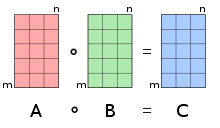在數學 中,阿達瑪乘積 (英語:Hadamard product ,又譯哈達瑪乘積 ),又名舒爾乘積 (Schur product )[ 1] 逐項乘積 (entrywise product )[ 2] :ch. 5 ,是一個二元運算 ,其輸入為兩個相同形狀的矩陣 ,輸出是具有同樣形狀的、各個位置的元素等於兩個輸入矩陣相同位置元素的乘積的矩陣。此乘積歸功於法國數學家雅克·阿達馬 或德國數學家伊賽·舒爾
作用在兩個相同形狀的矩陣上的阿達瑪乘積,結果是第三個相同形狀的矩陣。 「
逐項積 」重新導向至此。關於函數的逐點乘積,請見「
逐點乘積 」。
阿達瑪乘積滿足交換律 (當其元素屬於交換環時), 結合律 和對加法的分配律 :
A
∘
B
=
B
∘
A
,
A
∘
(
B
∘
C
)
=
(
A
∘
B
)
∘
C
,
A
∘
(
B
+
C
)
=
A
∘
B
+
A
∘
C
.
{\displaystyle {\begin{aligned}&\mathbf {A} \circ \mathbf {B} =\mathbf {B} \circ \mathbf {A} ,\\&\mathbf {A} \circ (\mathbf {B} \circ \mathbf {C} )=(\mathbf {A} \circ \mathbf {B} )\circ \mathbf {C} ,\\&\mathbf {A} \circ (\mathbf {B} +\mathbf {C} )=\mathbf {A} \circ \mathbf {B} +\mathbf {A} \circ \mathbf {C} .\end{aligned}}}
在阿達瑪乘積意義下,m × n 單位元 是全部元素均為1的m × n 。這跟普通矩陣乘法的單位元 只有主對角線上的元素為1的單位矩陣 不同。此外,若且唯若沒有任何元素等於 0 時,矩陣的阿達瑪乘積有逆矩陣。[ 3]
對於向量x y D x D y [ 2] :479
x
∗
(
A
∘
B
)
y
=
tr
(
D
x
∗
A
D
y
B
T
)
,
{\displaystyle \mathbf {x} ^{*}({A}\circ {B})\mathbf {y} =\operatorname {tr} \left({D}_{\mathbf {x} }^{*}{A}{D}_{\mathbf {y} }{B}^{\mathsf {T}}\right),}
x * x 共軛轉置 。特別的,使用全1向量,可以發現阿達瑪乘積的所有元素求和是AB T 矩陣轉置 )的跡 。對於方陣 A B AB T [ 4]
∑
i
(
A
∘
B
)
i
j
=
(
B
T
A
)
j
j
=
(
A
B
T
)
i
i
.
{\displaystyle \sum _{i}(A\circ B)_{ij}=\left(B^{\mathsf {T}}A\right)_{jj}=\left(AB^{\mathsf {T}}\right)_{ii}.}
(
y
x
∗
)
∘
A
=
D
y
A
D
x
∗
{\displaystyle \left(\mathbf {y} \mathbf {x} ^{*}\right)\circ {A}={D}_{\mathbf {y} }{A}{D}_{\mathbf {x} }^{*}}
(
A
∘
B
)
y
=
diag
(
A
D
y
B
T
)
{\displaystyle (A\circ B)\mathbf {y} =\operatorname {diag} \left(AD_{\mathbf {y} }B^{\mathsf {T}}\right)}
diag
(
M
)
{\displaystyle \operatorname {diag} (M)}
M
阿達瑪乘積是克羅內克乘積 的主要子矩陣 。
阿達瑪乘積滿足秩不等式
rank
(
A
∘
B
)
≤
rank
(
A
)
rank
(
B
)
{\displaystyle \operatorname {rank} ({A}\circ {B})\leq \operatorname {rank} ({A})\operatorname {rank} ({B})}
如果A B 正定矩陣 ,那麼下列不等式成立:[ 5]
∏
i
=
k
n
λ
i
(
A
∘
B
)
≥
∏
i
=
k
n
λ
i
(
A
B
)
,
k
=
1
,
…
,
n
,
{\displaystyle \prod _{i=k}^{n}\lambda _{i}({A}\circ {B})\geq \prod _{i=k}^{n}\lambda _{i}({A}{B}),\quad k=1,\ldots ,n,}
λi (A )A i 特徵值 。
如果D E 對角矩陣 ,那麼[ 6]
D
(
A
∘
B
)
E
=
(
D
A
E
)
∘
B
=
(
D
A
)
∘
(
B
E
)
=
(
A
E
)
∘
(
D
B
)
=
A
∘
(
D
B
E
)
.
{\displaystyle {\begin{aligned}{D}({A}\circ {B}){E}&=({D}{A}{E})\circ {B}=({D}{A})\circ ({B}{E})\\&=({A}{E})\circ ({D}{B})={A}\circ ({D}{B}{E}).\end{aligned}}}
兩個向量
a
{\displaystyle \mathbf {a} }
b
{\displaystyle \mathbf {b} }
對角矩陣 做矩陣乘法得到的結果相同:
a
∘
b
=
D
a
b
=
D
b
a
{\displaystyle \mathbf {a} \circ \mathbf {b} =D_{\mathbf {a} }\mathbf {b} =D_{\mathbf {b} }\mathbf {a} }
將向量映射到對角矩陣的
diag
{\displaystyle \operatorname {diag} }
diag
(
a
)
=
(
a
1
T
)
∘
I
{\displaystyle \operatorname {diag} (\mathbf {a} )=(\mathbf {a} \mathbf {1} ^{T})\circ I}
1
{\displaystyle \mathbf {1} }
全
1
{\displaystyle 1}
,
I
{\displaystyle I}
單位矩陣 。
^ Davis, Chandler. The norm of the Schur product operation. Numerische Mathematik. 1962, 4 (1): 343–44. doi:10.1007/bf01386329 ^ 2.0 2.1 Horn, Roger A.; Johnson, Charles R. Matrix analysis. Cambridge University Press. 2012. ^ Million, Elizabeth. The Hadamard Product (PDF) . [2 January 2012] . (原始內容 (PDF) 存檔於2013-06-12). ^ Styan, George P. H., Hadamard Products and Multivariate Statistical Analysis, Linear Algebra and Its Applications, 1973, 6 : 217–240, doi:10.1016/0024-3795(73)90023-2 hdl:10338.dmlcz/102190 ^ Hiai, Fumio; Lin, Minghua. On an eigenvalue inequality involving the Hadamard product. Linear Algebra and Its Applications. February 2017, 515 : 313–320. doi:10.1016/j.laa.2016.11.017 ^ Project (PDF) . buzzard.ups.edu. 2007 [2019-12-18 ] . (原始內容 (PDF) 存檔於2013-06-12).
